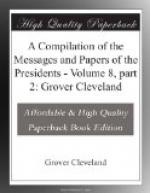It is sufficient for the present argument that the identity of the lines pointed out by the proclamation of 1763 and the act of 1774 with the boundary of the treaty of 1783 be admitted. Such has been the uniform claim of the Government of the United States and the State of Massachusetts, and such is the deliberate verdict of the British commissioners.[57] The words of the proclamation of 1763 have already been cited. By reference to them it will be seen that the origin of “the highlands” is to be sought on the north shore of the Bay of Chaleurs. If they are not to be found there, a gap exists in the boundary of the proclamation, which it is evident could not have been intended. It has been thought by some that the gap did actually exist, but this idea was founded on an imperfect knowledge of the country. The Bay of Chaleurs seems, in fact, to have been better known to the framers of the proclamation of 1763 and the act of 1774 than to any subsequent authorities, whether British or American. Researches made in the year 1840 show that at the head of the tide of the Bay of Chaleurs a mountain rises immediately on the northern bank, which from its imposing appearance has been called by the Scotch settlers at its foot Ben Lomond. This, indeed, has by measurement been found to be no more than 1,024 feet in height, but no one can deny its title to the name of a highland. From this a continuous chain of heights has been ascertained to exist, bounding in the first instance the valley of the Matapediac to the sources of that stream, which they separate from those of the Metis. The height of land then passes between the waters of Metis and Restigouche, and, bending around the sources of the latter to the sources of the Rimouski, begins there to separate waters which fall into the St. Lawrence from those which fall into the St. John, which they continue to do as far as the point where they merge in the line admitted by both parties.
[Footnote 57: Report of Featherstonhaugh and Mudge, pp. 6, 23.]
These highlands have all the characteristics necessary to constitute them the highlands of the treaty. Throughout their whole northern and western slopes flow streams which empty themselves into the St. Lawrence. Beginning at the Bay of Chaleurs, they in the first place divide, as it is necessary they should, waters which fall into that bay; they next separate the waters of Restigouche from those of Metis; they then make a great detour to the south and inclose the valley of Rimouski, separating its waters from those of Matapediac and Restigouche, the Green River of St. John and Tuladi; they next perform a circuit around Lake Temiscouata, separating its basin from those of the Otty and Trois Pistoles, until they reach the Temiscouata portage at Mount Paradis. This portage they cross five times, and finally, bending backward to the north, inclose the stream of the St. Francis, whose waters they divide from those of Trois Pistoles, Du Loup,




